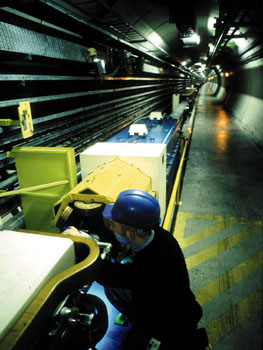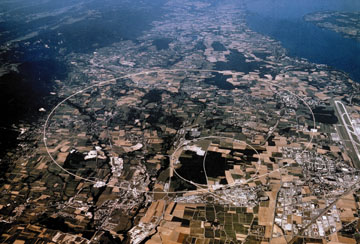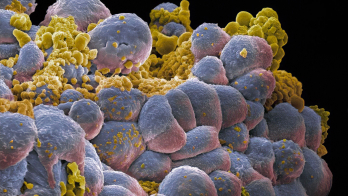In the last 10 years electroweak, physics has been transformed from a subtle effect into big science. At the forefront of this effort has been CERN’s LEP electronpositron collider, which is now celebrating its tenth birthday.

The news broke in the September issue that CERN’s LEP electronpositron collider was running at 100 GeV per beam (giving a total collision energy of 200 GeV) and giving very stable conditions.
Some 10 years ago, equipped with room temperature copper radiofrequency cavities, LEP began operating at 45 GeV per beam. From 1995, superconducting radiofrequency began to be added and the machine’s energy increased initially to 65 GeV per beam, then to 80.5 GeV in 1996 and to 94.5 GeV in 1998.
While this dramatic boost in collision energy via superconducting radiofrequency power looks like a latter-day accomplishment, from the very outset LEP was foreseen as being capable of attaining at least 100 GeV beams. The pioneer 1976 study group (which included Burt Richter, visiting CERN from SLAC in Stanford) addressed a machine that was designed to achieve a beam energy of 100 GeV and a luminosity (which is a measure of the particle collision rate) of 1032/sq. cm/s. Electrons are very light particles, so electron rings have to combat losses owing to synchrotron radiation as the beams are bent. To minimize these losses, the LEP circumference was made as large as possible. Therefore the magnets do not have to be very powerful.
Protons, however, do not lose much energy via synchrotron radiation and proton rings can be compact, with powerful magnets to bend the beams. As a result, CERN has its 27 km LEP ring running with electrons and positrons at 100 GeV. However, the protons in the LHC machine, built in the same tunnel, go beyond 8 TeV.
The 1977 LEP study group looked at 100 GeV per beam or more in a 51 km circumference ring, but, because of technical difficulties and the cost, a study for a machine half the size of LEP-100 was prepared. In 1978 the study group produced a 22 km ring design aimed at 70 GeV, and the emerging 1979 design foresaw a 31 km ring with stored beams capable of being taken from an injection level of 22 GeV up to 130 GeV, with an initial operation of 86 GeV. The ring was subsequently trimmed to 27 km and, as approved by CERN Council in 1981, LEP was optimized for a beam energy of 80100 GeV but with an initial operation phase of up to 55 GeV. The initial LEP study group at CERN was led by Eberhard Keil, Wolfgang Schnell and Kees Zilverschoon. Emilio Picasso became project director in 1981.
LEP’s initial physics goal was to find and make precision measurements of the Z, which is the neutral carrier of the weak interaction. Using the freshly minted electroweak model, other experiments in the late 1970s and early 1980s began to hint that the mass of the Z and its electrically charged W companion were around 100 GeV.
Synthesizing the Z in electronpositron annihilations would need only 50 GeV per beam, but the W, which has to be produced in oppositely charged pairs, would need twice as much beam energy. Thus LEP had to be capable of producing W pairs.

However, by the time the final LEP design report had been formulated in 1984, the W and the Z had been discovered at CERN’s protonantiproton collider with masses of around 80 and 90 GeV respectively. The lattice of magnets, which hold LEP’s electrons and positrons on track, was optimized for the 80-100 GeV beam energy range.
Although the Z had been found, LEP still had the formidable task of making precision measurements of this particle. An electron ring that is optimized for running at around 80 GeV per beam is not unduly taxed when running at 45 GeV per beam to produce Z particles. From 1989 to 1995 the four LEP experiments amassed between them some 20 million Zs.
Meanwhile, work had been under way to ensure that the superconducting radiofrequency power would be available for the higher-energy LEP beams the R&D programme had begun even before LEP had been formally approved. With sufficient superconducting accelerating power on board, the four LEP experiments began logging the production of W pairs in 1996, and this physics too became the subject of precision study.
As these electroweak data began to pile up, another physics horizon beckoned. At the heart of the electroweak model is the mysterious Higgs mechanism, which endows the vacuum with a preferred direction. Higgs particles have to be present to make the electroweak theory tick, but the theory can predict very little about them.
No explicit sign of Higgs particles had turned up by the time the W pair threshold had been reached at 80.5 GeV per beam. However, physicists had another lever to prise open the Higgs door. The interconsistency of the accumulated electroweak data limits where the Higgs particles can be, even if the particles are as yet invisible. In the same way that parallax measurements from two telescopes give a better fix on a distant star than can be achieved by a single sighting, electroweak measurements from different sectors give a sharper picture with less room for the Higgs to maneouvre.
With the electroweak prize at stake, LEP’s beam energy was pushed beyond the W pair threshold from 1998. When the beam energy is increased from 80 to 100 GeV, the electrons and positrons lose 2.44 times as much energy via synchrotron radiation and these losses have to be compensated for by superconducting power.
That this can be achieved is the ultimate success of LEP’s superconducting radiofrequency programme and its attendant cryogenics. The continually increasing collision rate (luminosity) at these higher energies reflects the foresight of the LEP machine designers, who ensured that the ring had all of the necessary beam-handling power right from the beginning. The trick was to allow for flexible phase advance, which focused the beams more tightly as the energy increased, to combat their natural tendency to increase in size.








